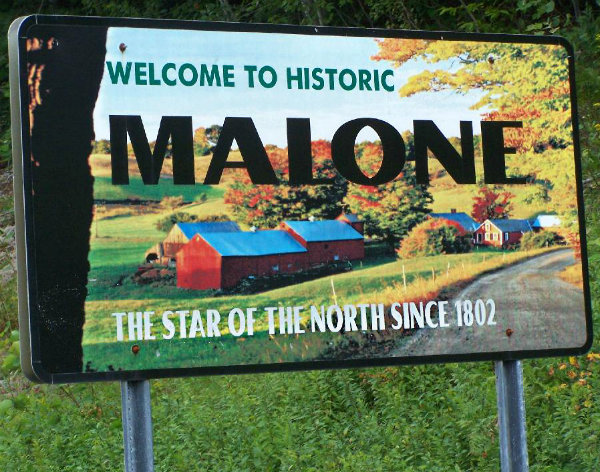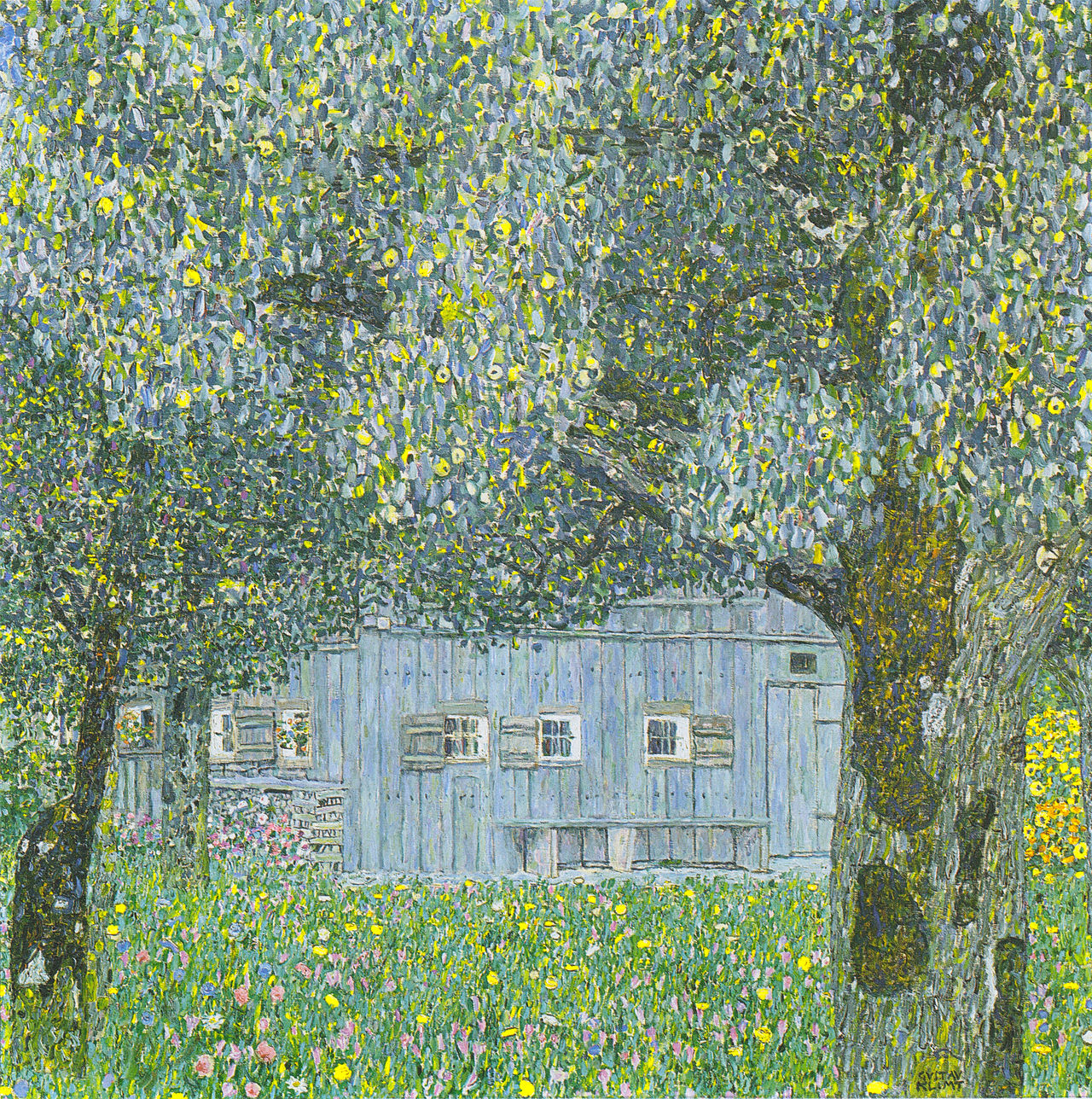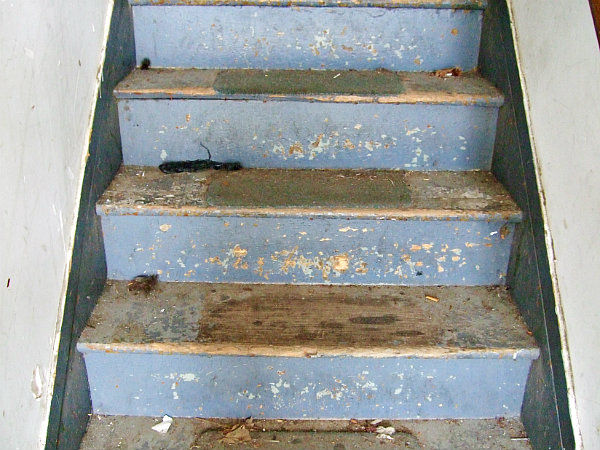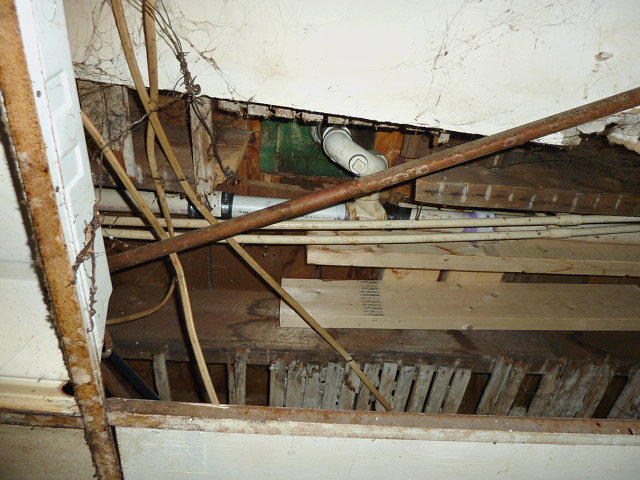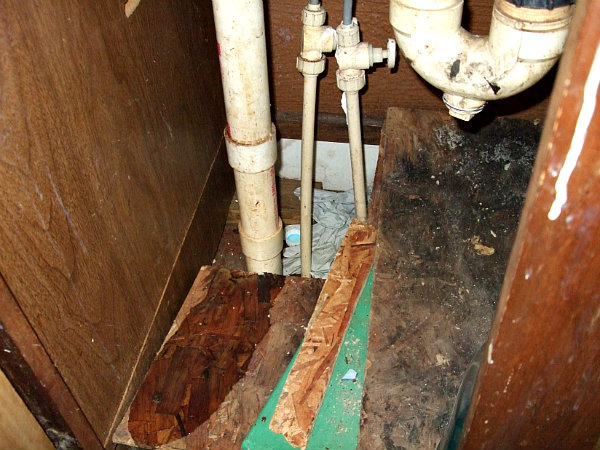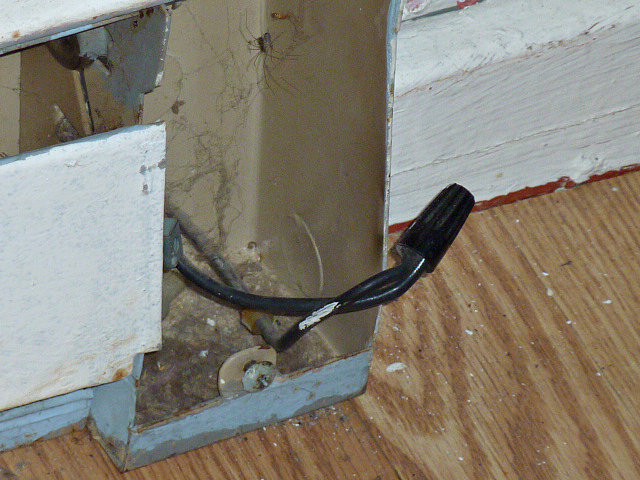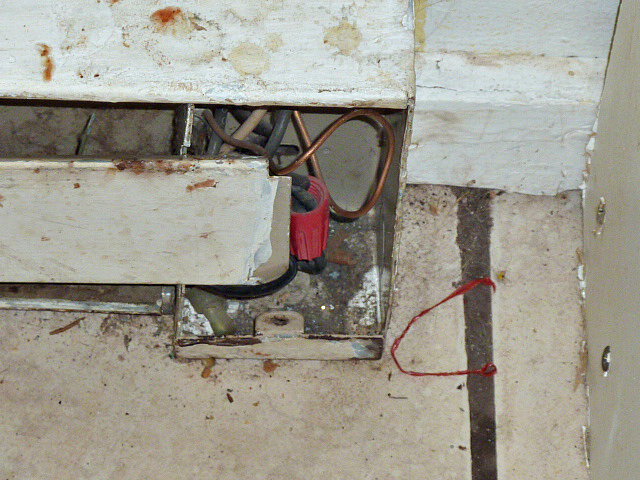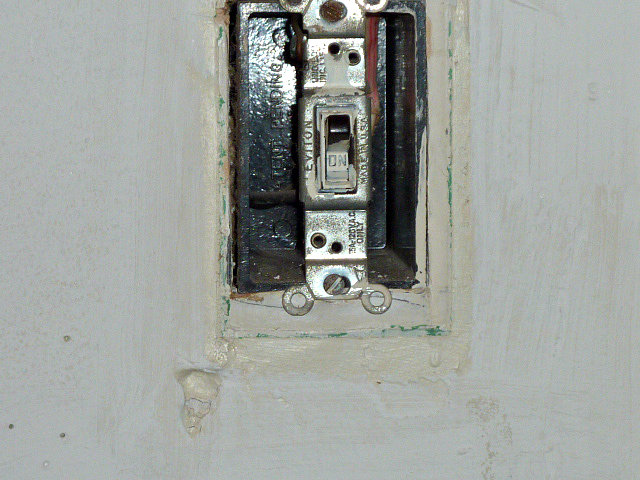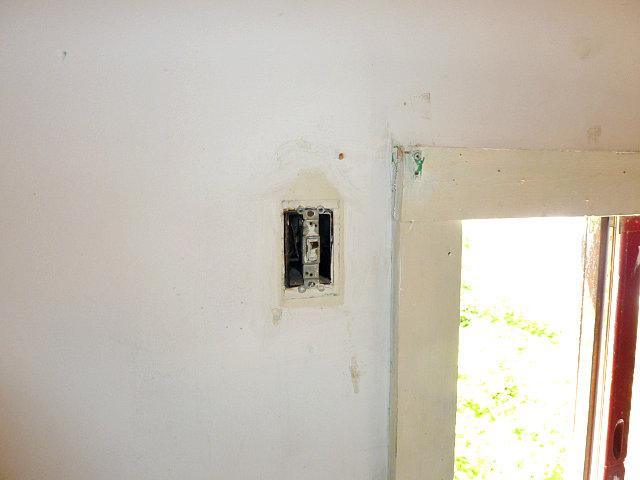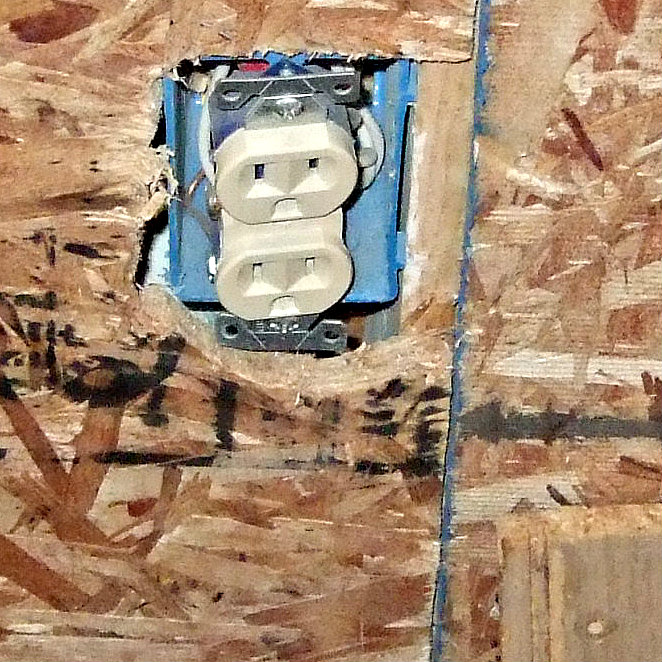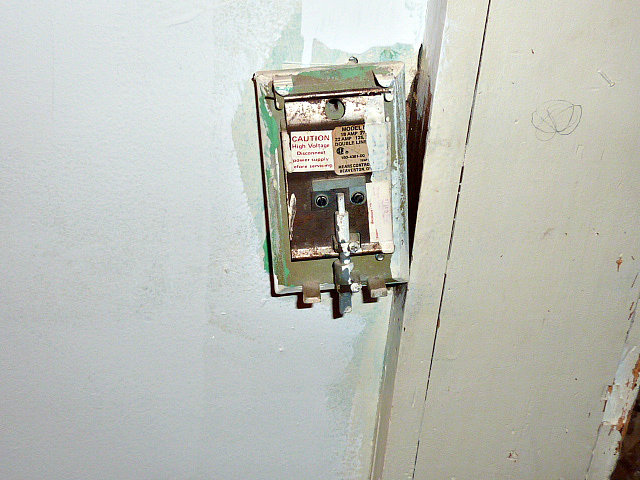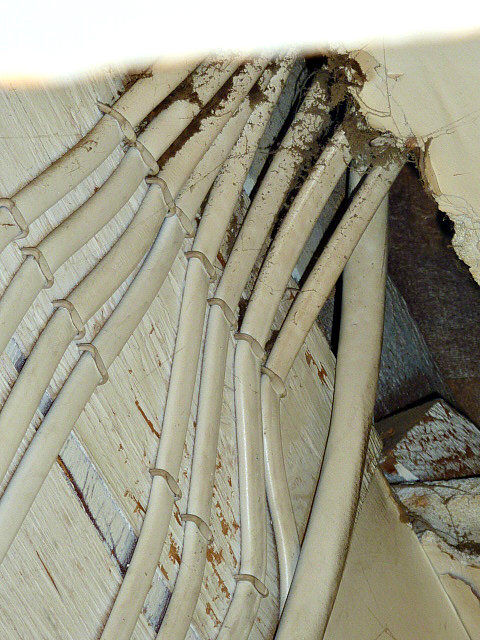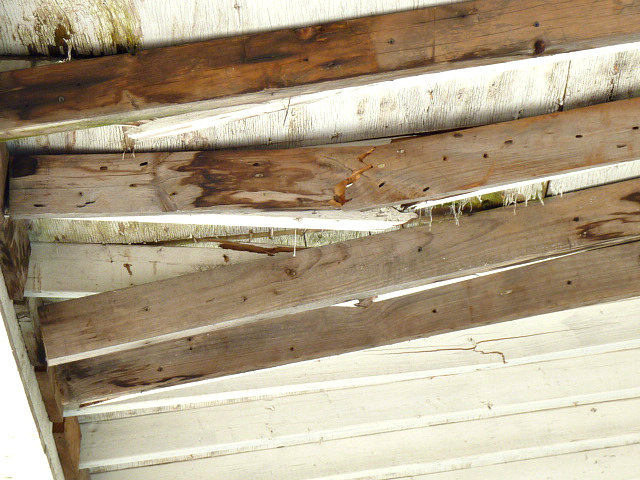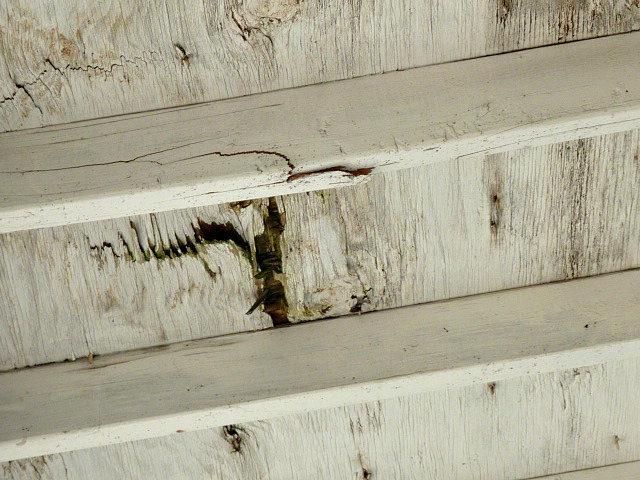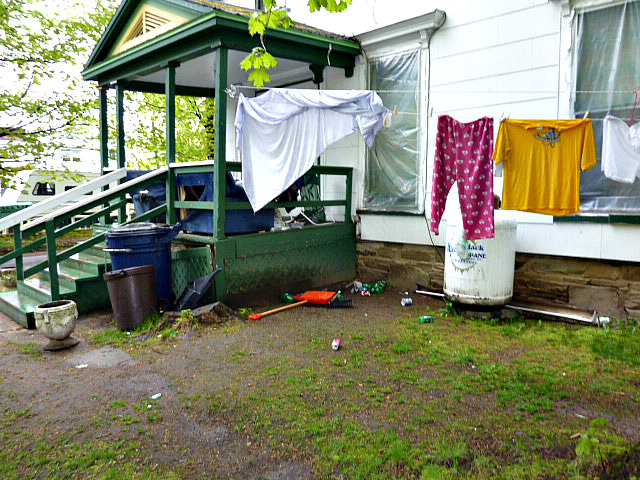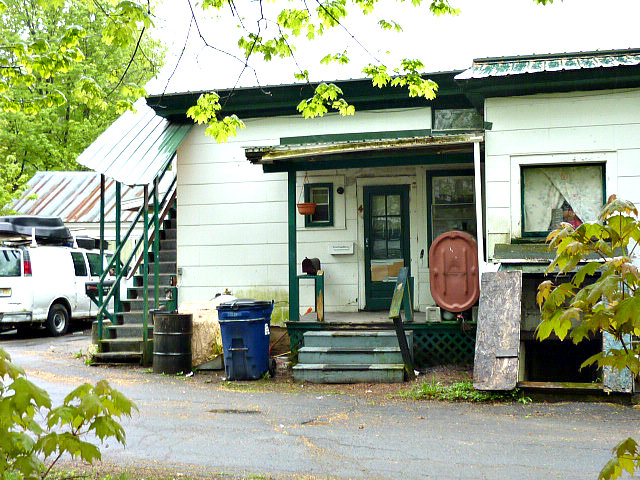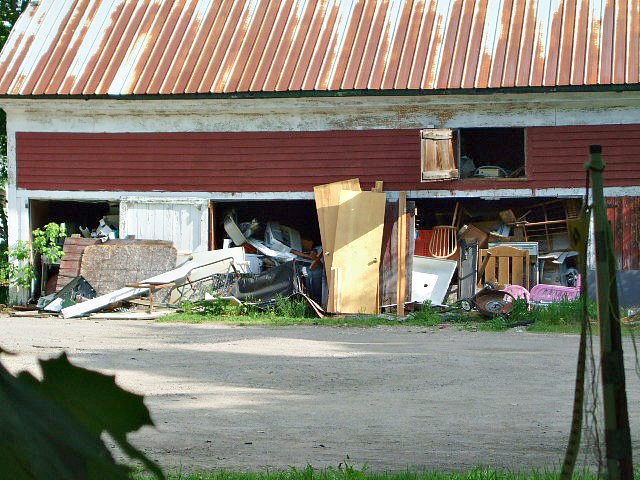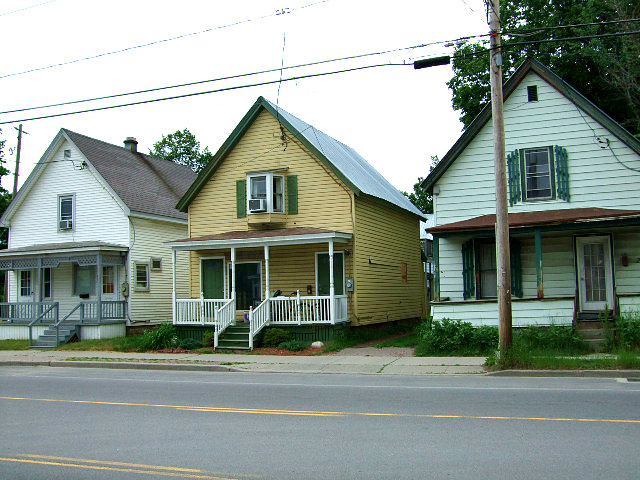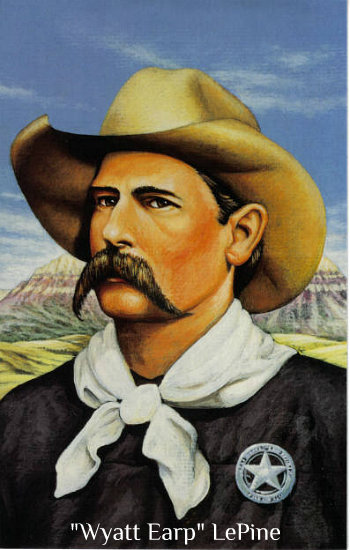
News Flash!
Ladies & gentlemen, there’s a new mayor in town. I mean, a new breed of mayor. Mayor Todd LePine.
Since publishing the article, below, RiverCityMalone.com has learned that Mayor LePine had himself deputized as a part-time Code Officer. Over the past week, Officer LePine and Officer Charlie Robert have been inspecting slum housing throughout the village and issuing numerous Code Violations. This is unprecedented! A breath of fresh air!
Ladies & gentlemen, after a series of disappointing men and women occupying the Big Desk at City Hall, it’s looking like Malone finally has a real, honest-to-god mayor!
»»»»»»
“Part One” in this series argued that Malone is being strangled by slums. Slums that take the form of either unoccupied, derelict buildings, or buildings with tenants whose rent is paid by “public assistance” (essentially DSS)—the latter being no more than publicly subsidized, taxpayer supported slums.
There are doubtless other categories of “slum” and “shanty housing” in the village; these two, above, are the most obvious and egregious.
I use the word “strangled.” Strangulation happens when a slum devalues surrounding properties. Strangulation happens as well when “slum behavior” creates what I call a reign of terror within a neighborhood.
(For an unforgettable, first-hand experience of this reign of terror, spend several days living on Milwaukee, Academy, or First St. Experience the violent, aggressive, shouted obscene language. The 2 am drunken parties complete with smashed beer bottles. Interview neighbors cowering indoors—the homeowners who describe themselves as prisoners inside their homes. This reign of terror has legs; it strolls up and down Washington & Clay Streets and others, at any hour of the day or night. Without exception, the individuals responsible for the reign of terror live in slums.)
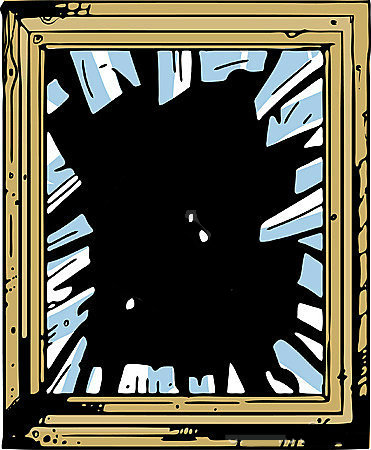
Part One featured Jack & Elvira Stewart for the following reasons:
(1) Because every single one of their 11 village properties is shamefully and unacceptably maintained.
(2) Because every single one of their 11 village properties is hammering neighboring property value.
(3) Because every single one of their 11 village properties is hammering neighboring quality of life owing to certain tenants (or tenants’ guests) whose language and behavior is often loud, aggressive, violent, and obscene (language). Tenants who are all in all a public nuisance, such that neighbors flee indoors when this riffraff begin their vile language and comportment out front or on the street or on the porch. (One must give credit where it’s due. I happen to know a number of Stewart renters, all of them have their rent paid by public assistance, and all the ones I know—are you ready for this?—are fine people. Of the tenants I know, none are drug dealers and none engage in the “reign of terror” referred to above. I’ll go even further. I know for a fact that Jack & Elvira have evicted known drug dealers and other scofflaws and degenerates.)
(4) Because every single one of their 11 village properties is subsidized by public money (rents) paid to Stewarts by the Franklin County Dept. of Social Services—our taxes, in other words.
(5) Because every single one of their 11 village properties is somehow, miraculously immune to the Village of Malone Code and the NYS Property Maintenance Code.
It’s worth repeating that all 11 buildings depend on public assistance rent payments. Without them, the entire Stewart enterprise would collapse.
I do not wish for it to collapse. I wish for it to thrive, so long as:
(a) the Stewarts provide decent, safe housing, and so long as,
(b) their properties are not a blight to their respective neighborhoods.
The Stewart properties fail, stupendously, on both counts. Read this transcript of an interview with one of their tenants. (Yes, we have it tape-recorded. The woman’s name has been changed for privacy reasons.)
My name is Jane Doe, I live in Apartment X, I’ve lived here for Y years, I’ve asked them [the Stewarts] many times to fix the pipe (or whatever’s going on) because it leaks all over. One time I stepped in it, not knowing it was wet. I slipped and I fell. (Lucky I didn’t break my hip.)
There’s no insulation in the building.
You ask them to fix something: they don’t really “fix” it; they “jury-rig” it. Then they tell you, “Oh, I’ll be back!”
They were supposed to put insulation or new walls up in one of the bedrooms because it’s ice cold in the wintertime. They kept promising, but they never did that. The heating: it’s so cold in here we have to “plastic” inside and out of our windows to keep the heat in. Even the walls: sometimes we have to do that to keep the heat in.
I am looking currently for a new place to live . . . .
And the floors are falling apart. They’re pulling apart that they put down. The tiles are cracking in the kitchen and not staying the way they should.
Whoever moves in here next needs to have all this done before they move in or they’re going to be very happy.
Compare her statement to Jack Stewart’s claims before the Village Board this past Monday evening (June 18):
Stewart said that when people call him with issues in the apartments he owns, he responds to their calls. ‘When they got a heating problem, I go,’ he said. ‘When they got a toilet problem, I go.’
Incidentally, here’s what the NYS Uniform Code says about landlord responsibilities for providing adequate heat:
602.2 Residential occupancies. Dwellings shall be provided with heating facilities capable of maintaining a room temperature of 68 degrees F (20 degrees C) in all habitable rooms, bathrooms and toilet rooms based on the winter design dry-bulb temperature for the locality indicated in the Energy Conservation Construction Code of New York State. Cooking appliances shall not be used to provide space heating to meet the requirements of this section. (Exception: Owner-occupied, one-family dwellings.)
Are Jack & Elvira unique for the 5 noxious conditions enumerated, above? Absolutely not; there are others equally as reprehensible. However, with 11 rentals throughout the village, the Stewart properties stand out like the proverbial sore thumb.
Should the Stewarts be held accountable for tenants’ behavior? Absolutely! (I say this as a former landlord descended from a family of landlords.)
Do the Stewarts have a right to inflict their shabby properties on our neighborhoods? Absolutely not! Every community in every society known to history has been held together by a social “glue” known as the “social contract.” Jesus put it succinctly as “Love your neighbor as yourself.”
One of the pillars of the social contract is the largely unspoken agreement to maintain one’s behavior and property in the tradition established by one’s community (read “neighborhood”). People (e.g., hermits, frontiersmen, homesteaders, etc.) who find these standards burdensome or unacceptable move out of town to secluded, country living—just as Jack & Elvira have done with their own home in Skerry. It’s fine for the Stewarts to live as they wish in the wilderness of Skerry; it is not fine for them to inflict their unneighborly living conditions on this village. (Click here for historical background to social contract theory and principles.)
The Village of Malone owes its very existence to the social contract. My case against the Stewarts is that, together with a minority of other landlords, they violate the social charter. (Last Saturday, Jack confronted me with the question, “What’s your beef?” This, Jack, is my beef. It’s the beef my neighborhood has with you, as you’ve been repeatedly told by neighbors. It’s the beef of the Village of Malone, as you were gently reminded by the Village Board. Jack, I implore you, listen to us. Put aside your wrath and indignation and listen to us!)

A moment ago I said the social contract is largely unspoken. Let me amend that. The Village of Malone Code, the NYS Uniform Code, and the NYS Social Services Code are all codifications of the social contract.
Consider the NYS Social Services Code, which establishes the Dept. of Social Services (DSS). DSS is mandated to enforce the social contract of decent, safe, healthy living conditions for people on public assistance—people, in other words, living in the Stewarts’ apartments. (To quote from NYS statutory law, DSS is forbidden to support housing which is “dangerous, hazardous or detrimental to life or health.” That phrase, dear reader, is part and parcel of the social charter of all civilized societies.)
To landlords who gripe that public assistance tenants are often slobs and destructive, my response is blunt:
If you accept public assistance rent money, you are required by law to provide these people with decent, safe, and healthy housing—whether you like it or not, whether you think they’re slobs or degenerates or jerks or not. If they trash your apartment, fix it up; otherwise, don’t take public assistance money.
Slobs and degenerates and jerks can live like pigs on their own nickel; the taxpayer (via DSS) should not have to pay landlords to provide slobs and degenerates with squalid housing when such people can create comparable living conditions on their own slothful, “don’t-give-a-damn” initiative. The point of DSS is to elevate people out of this condition, sometimes despite themselves.
The purpose of DSS (taxpayer) support is to give these people decent housing, on the “social charter” premise they will treat it decently. If they violate their part of the “social charter” bargain, boot ’em out and take in public assistance tenants who will respect your decent housing.
DSS funding is not a license to trash apartments.
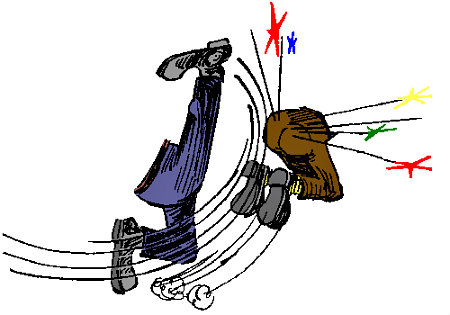
This means, of course, that landlords are required to do more than just cash DSS rent checks. They must monitor tenants and establish boundaries and standards of behavior which conform to the social contract. If landlords can’t or won’t do this, they’re in the wrong line of business and owe it to the community to get out of “renting houses.”
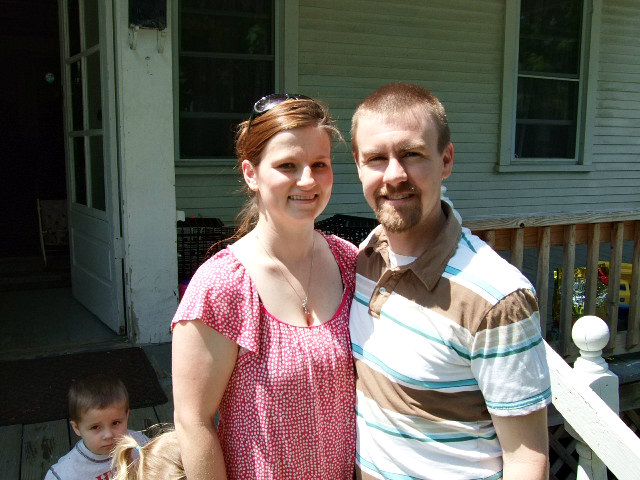
The good news is, there are in fact landlords who do accept public assistance rents and do evict “bad apples” and do monitor the behavior of the remainder, and who consistently operate decent, safe, and healthy apartment rentals.
Pat & Liz Ward are among them. They own a rental next door to me which has several public assistance tenants.
Pat & Liz are currently renovating the apartment, below, to rent to a DSS family for $600/month. I’m here to tell you, my wife & I would live here:
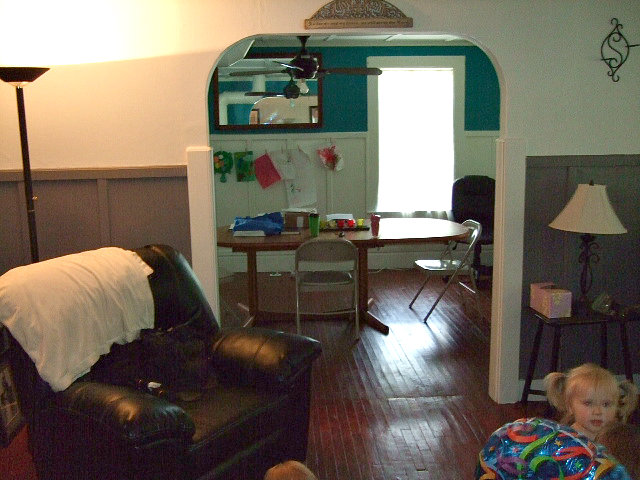
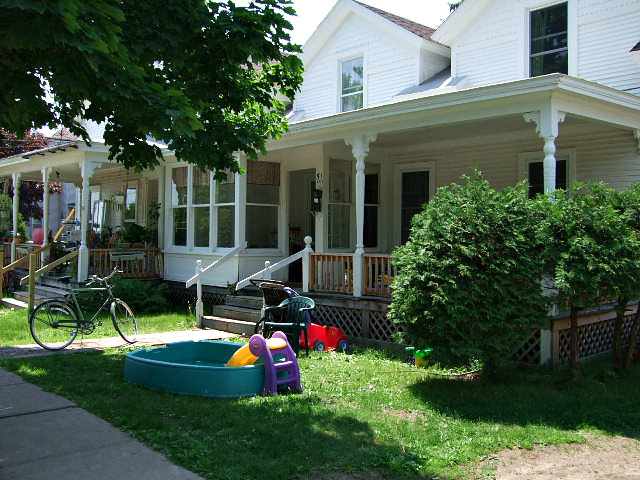

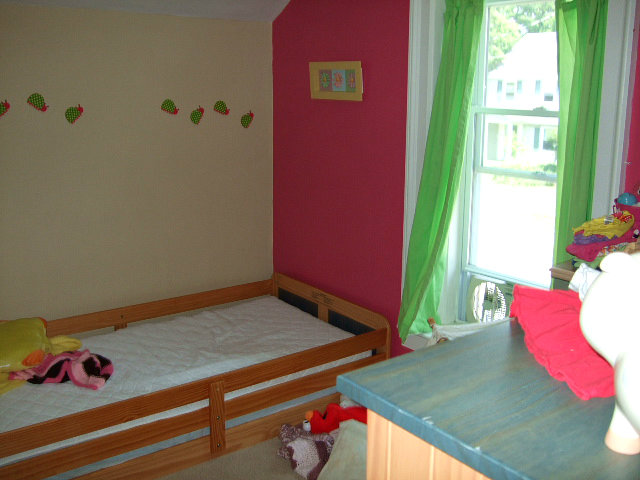
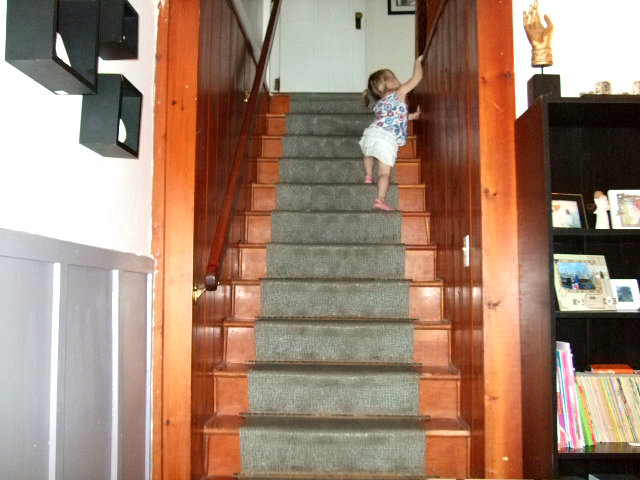
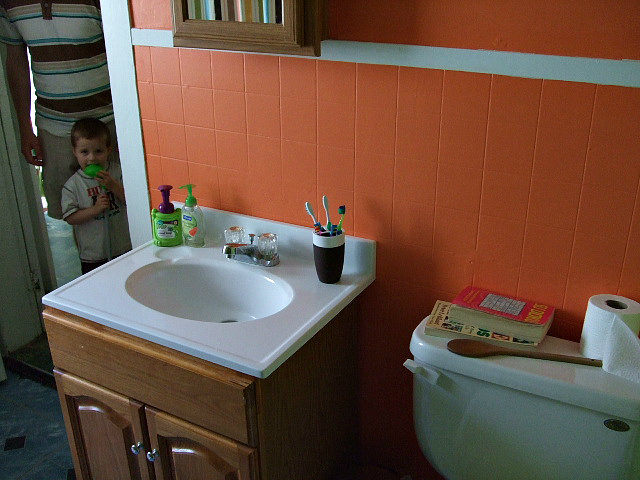
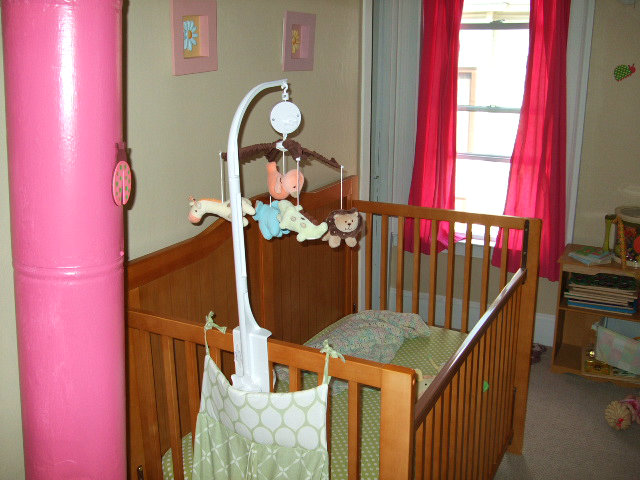
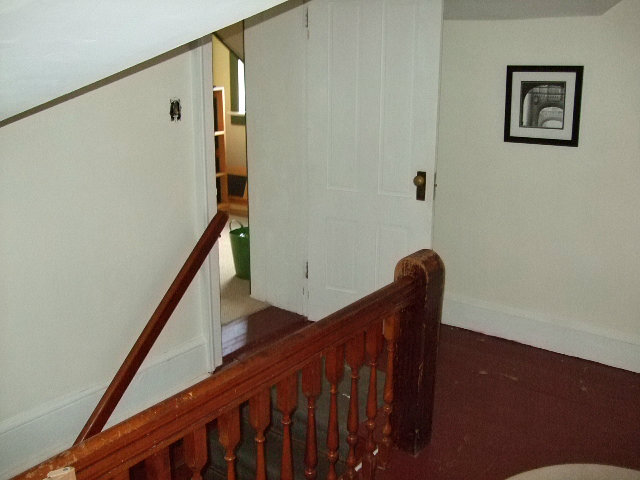
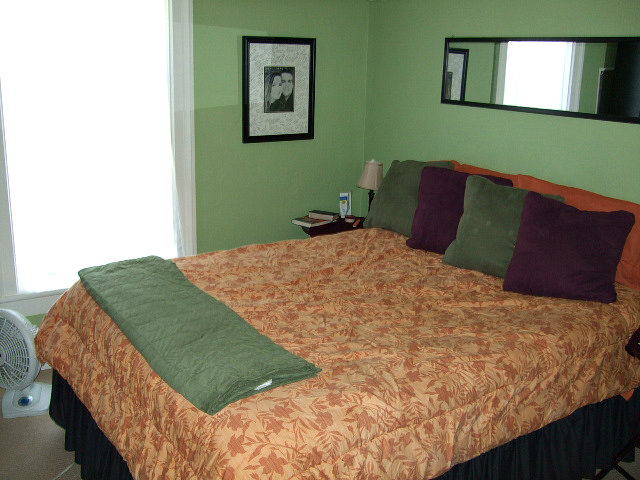
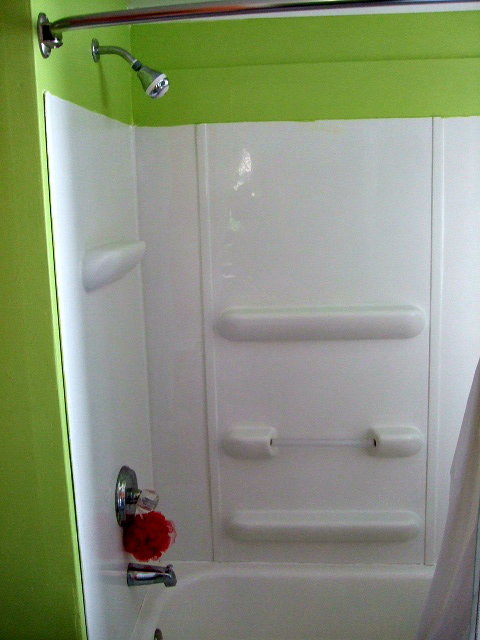

That’s:
» 3 bedrooms
» 1 full bath downstairs and half bath upstairs
» laundry room
» kitchen (with all appliances)
» dining room
» sun room
» off-street parking
» porch
Yes, for $600/month.
Pat and his family (above) are currently living in the apt. while they fix it up. Their plan is to buy as many distressed homes as they can afford in the Milwaukee, Washington, Pearl, Frederick Street area, fix ’em up and rent to DSS and other tenants.
The building, above, is their second rental building. The other one, as I say, is next door to me.
(Note to Jack & Elvira: What keeps you from doing the same?)
Back to the Village and NYS Uniform Code. Fire regulations, electrical standards, building codes, plumbing and heating and all property maintenance standards—all are part of the larger “social contract” which says, “We don’t subject people to fire or structural hazard and other risk and danger or harm, nor do we subject them to degraded, demeaning living or working conditions, nor do we subject neighborhoods and neighbors to hellish behavior—public annoyance, disturbing the peace—or slum and shanty housing.”
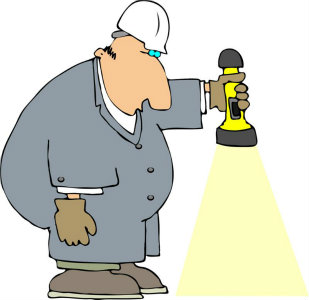
It is because of this time-honored social charter that the Village of Malone has a Code Enforcement Officer.
§22-3. Code Enforcement Officer; inspectors.
A. The office of Code Enforcement Officer is hereby created.
The Code Enforcement Officer shall administer and enforce all the provisions of the [NYS] Uniform Code, the Energy Code and this chapter. The Code Enforcement Officer shall have the following powers and duties:
(1) To receive, review, and approve or disapprove applications for building permits, certificates of occupancy, temporary certificates and operating permits, and the plans, specifications and construction documents submitted with such applications;
(2) Upon approval of such applications, to issue building permits, certificates of occupancy, temporary certificates and operating permits, and to include in building permits, certificates of occupancy, temporary certificates and operating permits such terms and conditions as the Code Enforcement Officer may determine to be appropriate;
(3) To conduct construction inspections, inspections to be made prior to the issuance of certificates of occupancy, temporary certificates and operating permits, firesafety and property maintenance inspections, inspections incidental to the investigation of complaints, and all other inspections required or permitted under any provision of this chapter;
(4) To issue stop-work orders;
(5) To review and investigate complaints;
(6) To issue orders pursuant to §22-15A, Compliance orders, of this chapter;
(7) To maintain records;
(8) To collect fees as set by the governing board of this Municipality;
(9) To pursue administrative enforcement actions and proceedings;
(10) In consultation with this Municipality’s attorney, to pursue such legal actions and proceedings as may be necessary to enforce the [NYS] Uniform Code, the Energy Code and this chapter, or to abate or correct conditions not in compliance with the [NYS] Uniform Code, the Energy Code or this chapter; and
(11) To exercise all other powers and fulfill all other duties conferred upon the Code Enforcement Officer by this chapter.
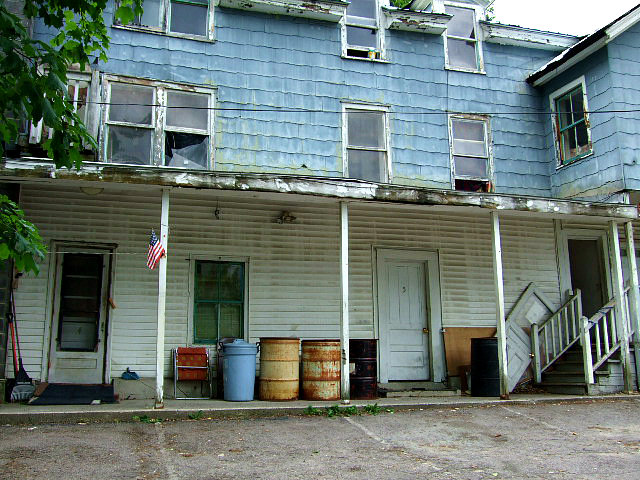
Now open the link to the NYS Uniform Code. Focus on the Property Maintenance Code (line #9 in the NYS Uniform Code). In particular, consider what the Code refers to as “Unsafe Buildings” (the relevant clauses are quoted, below). By the way, according to the Village of Malone Code,
§22-9. Unsafe buildings and structures . . . and equipment in this Municipality shall be identified and addressed in accordance with the procedures adopted by the Municipality from time to time or as set forth in any applicable state law.
The “applicable state law” being, of course, the NYS Uniform Code.
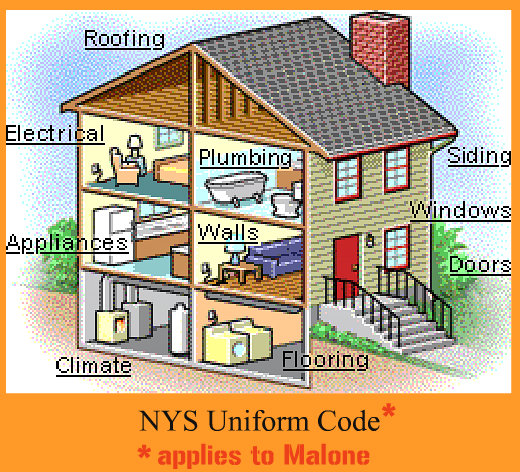
.
Now consider several Stewart properties in relation to the Village Code and NYS Uniform Code, while keeping in mind that the NYS Uniform Code always takes precedence over (“trumps”) the Village Code. In each snapshot, below, match the photo with the relevant Code, where blue text is Village Code and green text is NYS Uniform Code. (All these photos are from various Stewart properties in the Village of Malone.)
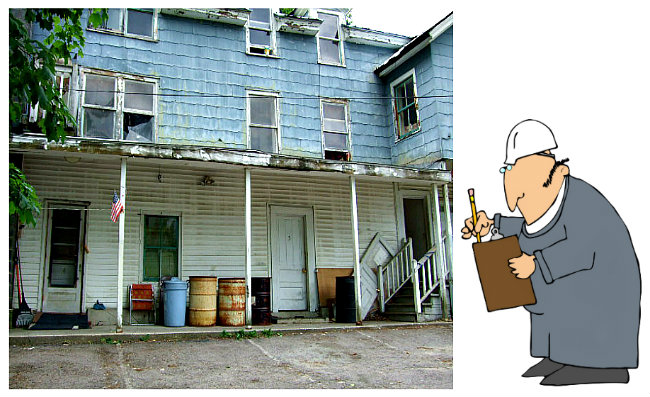
§57-1. Unsafe buildings defined. All buildings or structures which have any or all of the following defects shall be deemed “unsafe buildings.”
C. Those which have improperly distributed loads upon the floors or roofs or in which the same are overloaded, or which have insufficient strength to be reasonably safe for the purpose used.
D. Those which have been damaged by fire, wind or other causes so as to have become dangerous to life, safety, morals or the general health and welfare of the occupants or the people of the Village of Malone.
E. Those which have become or are so dilapidated, decayed, unsafe, unsanitary or which so utterly fail to provide the amenities essential to decent living that they are unfit for human habitation, or are likely to cause sickness or disease, so as to work injury to the health, morals, safety or general welfare of those living therein.
I. Those which, because of their condition, are unsafe, unsanitary or dangerous to the health, morals, safety or general welfare of the people of the Village of Malone.
107.1.1 Unsafe structures. An unsafe structure is one that is found to be dangerous to the life, health, property or safety of the public or the occupants of the structure by not providing minimum safeguards to protect or warn occupants in the event of fire, or because such structure contains unsafe equipment or is so damaged, decayed, dilapidated, structurally unsafe, or of such faulty construction or unstable foundation, that partial or complete collapse is possible.
107.1.3 Structure unfit for human occupancy. A structure is unfit for human occupancy whenever such structure is unsafe, unlawful or, because of the degree to which the structure is in disrepair or lacks maintenance, is insanitary, vermin or rat infested, contains filth and contamination, or lacks ventilation, illumination, sanitary or heating facilities or other essential equipment required by this code, or because the location of the structure constitutes a hazard to the occupants of the structure or to the public.
604.3 Electrical system hazards. Where it is found that the electrical system in a structure constitutes a hazard to the occupants or the structure by reason of . . . improper wiring or installation, deterioration or damage, or for similar reasons, the defects shall be corrected to eliminate the hazard.
504.1 General. All plumbing fixtures shall be properly installed and maintained in working order, and shall be kept free from obstructions, leaks and defects and be capable of performing the function for which such plumbing fixtures are designed. All plumbing fixtures shall be maintained in a safe, sanitary and functional condition.
605.1 Installation. All electrical equipment, wiring and appliances shall be properly installed and maintained in a safe and approved manner.
107.1.2 Unsafe equipment. Unsafe equipment includes any boiler, heating equipment . . . electrical wiring or device, flammable liquid containers or other equipment on the premises or within the structure which is in such disrepair or condition that such equipment is a hazard to life, health, property or safety of the public or occupants of the premises or structure.
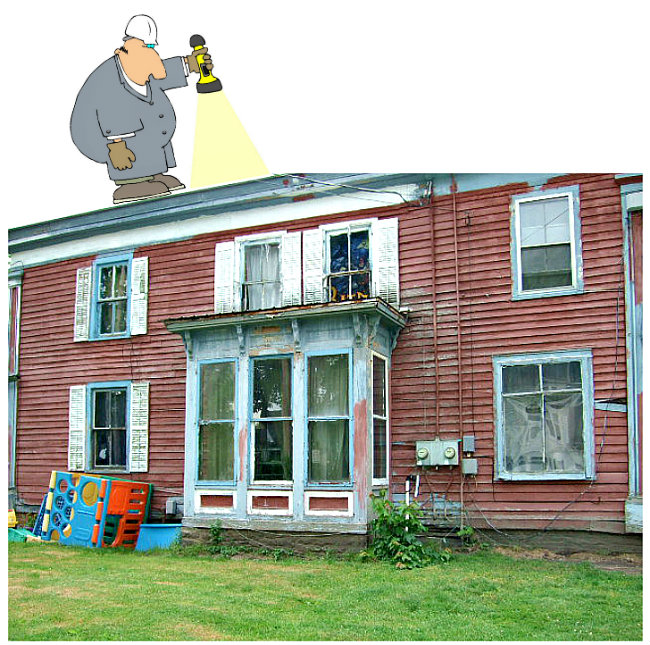
Fire Prevention and Building Code. §22-6. Inspections.
B. Frequency of inspections.
(1) All dwelling units in a building consisting of more than two (2) such units shall be inspected for the purpose of determining compliance with safety requirements of the [NYS] Uniform Code at least once every eighteen (18) months. Inspection of common areas of such buildings, such as halls, foyers, staircases. etc., shall be so inspected at least once in every twelve (12) months.
Littering §31A-2. Deposit prohibited.
It shall be unlawful for any person to throw, drop, discard or otherwise place litter, garbage, refuse or rubbish of any nature upon any public or private property, other than in a proper receptacle. It also shall be unlawful to deposit any material which by law should be recycled.
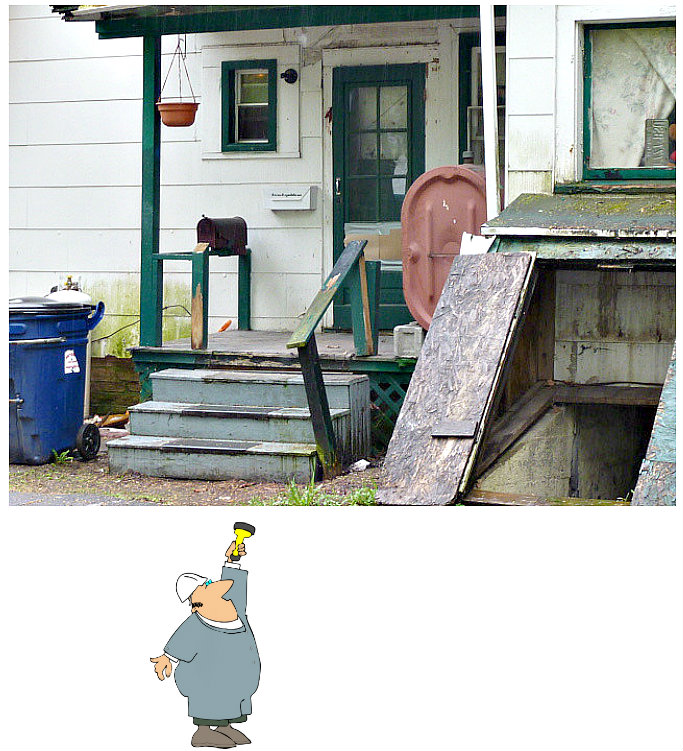
§22-11. Firesafety inspections and property maintenance:
A. Inspections required. Firesafety and property maintenance inspections of buildings and structures shall be performed by the Code Enforcement Officer or an inspector designated by the Code Enforcement Officer at the following intervals:
(3) Firesafety and property maintenance inspections of all multiple dwellings not included in Subsection A(l) and (2), and all nonresidential buildings, structures, uses and occupancies not included in Subsection A(l) or (2) shall be performed at least once every 36 months.
B. Inspections permitted. In addition to the inspections required by Subsection A of this section, a fire safety and property maintenance inspection of any buildingstructure, use, or occupancy, or of any dwelling unit, may also be performed by the Code Enforcement Officer or an inspector designated by the Code Enforcement Officer at any time in the following instances . . . :
(3) Receipt by the Code Enforcement Officer of any other information, reasonably believed by the Code Enforcement Officer to be reliable, giving rise to reasonable cause to believe that conditions or activities failing to comply with the Uniform Code or Energy Code exist.
§31A-7. Waste generated outside of premises; property maintenance.
A. No person shall throw or deposit litter, garbage, refuse or rubbish on any private property within the village, whether owned by such person or not, except the owner or person in control of private property may maintain authorized private receptacles for collection.
B. Such owner or person in control of private property shall at all times maintain the premises free of litter, garbage, refuse or rubbish; provided, however, that this section shall not prohibit the storage of litter in private receptacles for collections.
C. Such receptacles are to be kept clean and from public view except on collection day(s).
§37B-4. Outdoor deposit or storage of waste.
A. No person, as owner, occupant, lessee or agent, or in any capacity, shall store, deposit, place, maintain or cause or permit to be stored, deposited, placed or maintained outdoors any abandoned, junked, discarded, wholly or partially dismantled, unlicensed or unregistered motor vehicles, or any solid waste, rubbish, or debris, upon any private property within the Village for more than five days. This section shall not apply to any solid waste, rubbish or debris temporarily stored or placed in a container for collection or disposal. All appliances must have their doors either secured or removed while stored outside in preparation for removal.
§57-2. Standards for repair, vacation [vacating the building] or demolition. The following standards shall be followed, in substance, by the Code Enforcement Officer and the Board of Trustees in ordering repair, vacation or demolition:
A. If the unsafe building can reasonably be repaired so that it will no longer exist in violation of the terms of this chapter, it shall be ordered repaired.
B. If the unsafe building is in such condition as to make it dangerous to the health, morals, safety or general welfare of its occupants, it shall be ordered to be vacated.
C. In any case where an unsafe building is so damaged or decayed, or deteriorated from its original value or structure so that it cannot be economically restored, it shall be ordered demolished, and in all cases where a building cannot be repaired so that it will no longer exist in violation of the terms of this chapter, it shall be demolished. In all cases where an unsafe building is a fire hazard existing or erected in violation of the terms of this chapter, or any other provisions of this Municipal Code or laws of the State of New York, it shall be demolished.
One of these 3 homes, directly across E. Main Street from Fat Jake’s, was purchased by the Stewarts recently, we’ve been told by a realtor. What will be its fate?
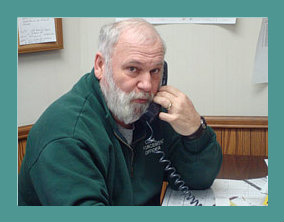
So, where’s the Code Officer? Presently, there is only one Code Officer (Charlie Robert), who works half time. (Gordy Halley resigned several months ago.)
The Village Board is looking to hire a full-time Code Officer to join Charlie.
Where’s Charlie? Why isn’t he writing scores of violations on the Stewart buildings, along with a host of other buildings? Why are Code violations not reaching the Municipal Court? (I have been told by a Village Trustee, who was in conversation with one of our Municipal Judges, that the Court has not seen a property management Code violation in 10 years. If this is true, something is terribly wrong.)
I don’t have definitive answers to these questions. Every taxpayer in the Village should be asking them, however. Whatever the reasons, the Village Code Office is seriously broken.
Notice, I said the Code Office is dysfunctional; I didn’t say Charlie Robert is dysfunctional. I’ve known and admired Charlie for years; this is not a dysfunctional man or public officer. I suggest the problem is not Charlie Robert; I suggest the root of the problem is the way the Code Office has been managed by the Trustees and Mayor since time out of memory.
In other words, my guess is Charlie inherited a Code Office that was not prepared to deal with slum housing and shanty buildings. And that, furthermore, previous Village Boards and Mayors took a “don’t rock the boat” approach to slum housing and shanty buildings, such that Code Officers had little incentive and encouragement to pursue the problem.
Be that as it may, no one can dispute that Code Enforcement is a task well beyond the capabilities of a half-time Officer. (A round of applause to the Mayor and Village Board for acknowledging the “slum crisis” and deciding to hire a full-time Code Officer to work alongside Charlie!)
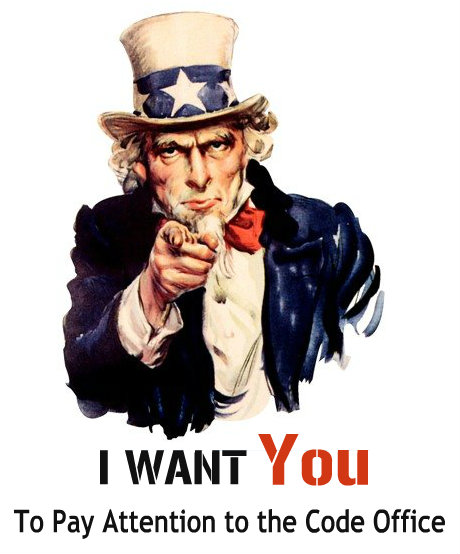
We—all of us—must pay attention to the Code Office from now on. The Code Office holds the key to keeping the Village alive. No longer can we, as a community, adopt a laissez-faire attitude to slums, especially when slumlords are making a handsome “buck” off their squalid buildings—at significant financial and “quality of life” cost to the community. (Laissez-faire, pronounced “lay-say fare,” is a French term for a policy of “non-interference.”)
Here’s what to expect from the new Code Officer—quoted from the Village Code Book. We must be vociferous and insist he discharge his duties as follows. (Text highlighted in maroon is especially significant to the Code Officer. As you read, notice the role of the Village Police Dept. in Code enforcement. References to the Village Police are highlighted in crimson.)
§57-3. Unsafe buildings; nuisances.
All unsafe buildings within the terms of §57-1 of this chapter are hereby declared to be public nuisances, and shall be repaired, vacated or demolished as hereinbefore and hereinafter provided.
§57-4. Duties of Code Enforcement Officer.
The Code Enforcement Officer shall:
A. Inspect any building, wall or structure about which complaints are filed by any person to the effect that a building, wall or structure is or may be existing in violation of this chapter, and report his findings at least monthly to the Board of Trustees or more frequently as requested by the Board or the Mayor.
B. Inspect any building, wall or structure reported (as hereinafter provided for) by the Police Department of this Village as probably existing in violation of the terms of this chapter.
C. When, in his opinion, he shall deem any structure existing in violation of this chapter, he shall cause a further examination thereof to be made by a licensed architect or professional engineer, after approval by the Village Board. Upon concurrence with the Code Enforcement Officer’s opinion by such architect or engineer, if required by the Village Board, the Code Enforcement Officer shall promptly notify personally, or in writing, the owner or someone of the owner’s executors, legal representatives, agents, lessees or any other person having vested or contingent interest in the property . . . of any building found by him to be an unsafe building within the standards set forth in §57-1 of this chapter.
(1) The owner must vacate, repair, or demolish said building in accordance with the terms of the notice and this chapter.
(2) The occupant or lessee must vacate said building or may have it repaired in accordance with the notice and remain in possession.
(3) Any mortgagee, agent or other persons having an interest in said building may, at his own risk, repair, vacate or demolish said building or have such work or act done; provided, that any person notified under this subsection to repair, vacate, or demolish any building shall be given such reasonable time, not exceeding 30 days, as may be necessary to do, or have done, the work or act required by the notice provided for herein.
D. Set forth in the notice provided for Subsection C hereof, a description of the building, or structure deemed unsafe, a statement of the particulars which make the building or structure an unsafe building and an order requiring the same to be put in such condition as to comply with terms of this chapter within such length of time, not exceeding 30 days, as is reasonable.
E. Report to the Board of Trustees any noncompliance with the notice provided for in Subsection C and D hereof.
F. Appear at all hearings conducted by the Board of Trustees, and testify as to the condition of unsafe buildings.
G. Place a notice on all unsafe buildings, reading as follows:
“This building has been found to be an unsafe building by this Code Enforcement Officer. This notice is to remain on this building until it is repaired, vacated or demolished in accordance with the notice which has been given the owner, or someone of the owner’s executors, legal representatives, agents, lessees or any other person having a vested or contingent interest in the property, by registered mail . . . of any building found by me to be an unsafe building within the standards set forth in §57-1 of Chapter 57 of the Village of Malone Municipal Code. It is unlawful to remove this notice until such notice is complied with.”
§57-6. Emergency cases.
In cases where it reasonably appears that there is immediate danger to the life or safety of any person unless an unsafe building as defined herein is immediately repaired, vacated or demolished, the Code Enforcement Officer shall report such facts to the Board of Trustees and the Board of Trustees shall cause the immediate repair, vacation or demolition of such unsafe building. The costs of such emergency repair, vacation or demolition of such unsafe building shall be collected in the same manner as provided in Subsection E of §57-5.
§57-8. Administrative liability.
No officer, agent or employee of the Village of Malone shall render himself personally liable for any damage that may accrue to the persons or property as a result of any act required or permitted in the discharge of his duties under this chapter.
Any suit brought against any officer, agent or employee of the Village of Malone as a result of any act required or permitted in the discharge of his duties under this chapter shall be defended by the Village until the final determination of the proceeding therein.
§57-9. Duties of Police Department.
All employees of the Village of Malone Police Department shall make a report in writing to the Code Enforcement Officer of any buildings or structures which are or may be deemed to be unsafe buildings within the terms of this chapter. Such reports must be delivered to the Code Enforcement Officer within 24 hours of the discovery of such building.
§57-10. Transfer of title.
The transfer of title by the owner of premises upon which an unsafe building or structure is located shall be no defense to any proceedings under this chapter.
§57-11. Violation and penalties.
A. Violation of any of the provisions of this chapter is hereby declared to be a violation pursuant to the State of New York Penal Law.
B. For every violation of any provision of this chapter, the person violating the same shall be subject to a fine of not more than $250 or imprisonment of not more than 15 days as provided in the Penal Law, or both such fine and imprisonment for each and every day such failure to comply continues beyond the date fixed for compliance.
I have repeatedly said the Code Office is broken. It’s not the only broken public agency. So, too, is the Franklin County Dept. of Social Services (DSS) when it administers rent payments (directly or indirectly) to slumlords.
Begin with DSS’s mission statement:
To promote the better well being, health, education, and safety of those we serve in a manner which provides dignity while encouraging the greatest self-sufficiency in those same individuals.
So far, so good. Now consider DSS’s legal obligations regarding rentals for public assistance “clients.” Notice the passages highlighted in maroon.
§143-b. Avoidance of abuses in connection with rent checks.
1. Whenever a recipient of public assistance and care is eligible for or entitled to receive aid or assistance in the form of a payment for or toward the rental of any housing accommodations occupied by such recipient or his family, such payment may be made directly by the public welfare department to the landlord.
2. Every public welfare official shall have power to and may withhold the payment of any such rent in any case where he has knowledge that there exists or there is outstanding any violation of law in respect to the building containing the housing accommodations occupied by the person entitled to such assistance which is dangerous, hazardous or detrimental to life or health. A report of each such violation shall be made to the appropriate public welfare department by the appropriate department or agency having jurisdiction over violations.
3. Every public welfare official shall have the power to initiate or to request the recipient to initiate before the appropriate housing rent commission any proper proceeding for the reduction of maximum rents applicable to any housing accommodation occupied by a person entitled to assistance in the form of a rent payment whenever such official has knowledge that essential services which such person is entitled to receive are not being maintained by the landlord or have been substantially reduced by the landlord.
4. The public welfare department may obtain and maintain current records of violations in buildings where welfare recipients reside which relate to conditions which are dangerous, hazardous or detrimental to life or health.
5. (a) It shall be a valid defense in any action or summary proceeding against a welfare recipient for non-payment of rent to show existing violations in the building wherein such welfare recipient resides which relate to conditions which are dangerous, hazardous or detrimental to life or health as the basis for non-payment.
(b) In any such action or proceeding the plaintiff or landlord shall not be entitled to an order or judgment awarding him possession of the premises or providing for removal of the tenant, or to a money judgment against the tenant, on the basis of non-payment of rent for any period during which there was outstanding any violation of law relating to dangerous or hazardous conditions or conditions detrimental to life or health. For the purposes of this paragraph such violation of law shall be deemed to have been removed and no longer outstanding upon the date when the condition constituting a violation was actually corrected, such date to be determined by the court upon satisfactory proof submitted by the plaintiff or landlord.
(c) The defenses provided herein in relation to an action or proceeding against a welfare recipient for non-payment of rent shall apply only with respect to violations reported to the appropriate public welfare department by the appropriate department or agency having jurisdiction over violations.
6. Nothing in this section shall prevent the public welfare department from making provision for payment of the rent which was withheld pursuant to this section upon proof satisfactory to it that the condition constituting a violation was actually corrected. Where rents were reduced by order of the appropriate rent commission, the public welfare department may make provision for payment of the reduced rent in conformity with such order.
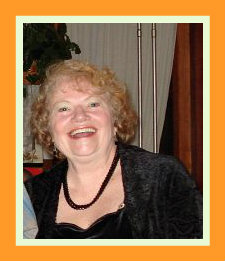
I interpret the highlighted passages to mean that Commissioner Lesley Lyon is obliged to cut off or slash DSS rents to landlords “in any case where she has knowledge that there exists any violation of law or failure to maintain essential services” where such violation of law or failure to maintain essential services is “dangerous, hazardous or detrimental to life or health” (Sec. 143-b-2,3).
I attended a meeting recently with Lesley Lyon and Charlie Robert and discovered that Lesley interprets her mandate differently—I would say, erroneously. Lesley has been waiting for the Code Office to notify her of “violations of law or failure to maintain essential services” before she initiates sanctions against slumlords. If I understood Charlie’s response, the Code Office was unaware of Lesley’s expectation.

Regardless of who expected “what” of “whom,” it’s time for the Code Office and DSS to start working together. If DSS won’t discipline slumlords without prior notification of violations by the Code Office, then so be it. Then the Code Officer needs to begin writing a blizzard of violations and copying them to DSS.
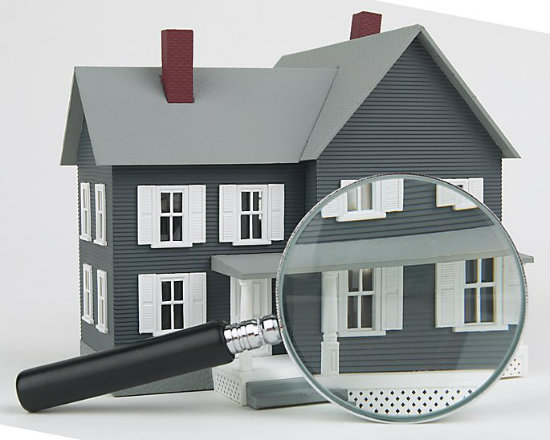
It all comes back to the social contract, the essential “glue” holding communities together—the “brake” that stops our disastrous slide into “Malone, the Slum of the North since . . .”
